The Moon Nodes and the Force of Destiny
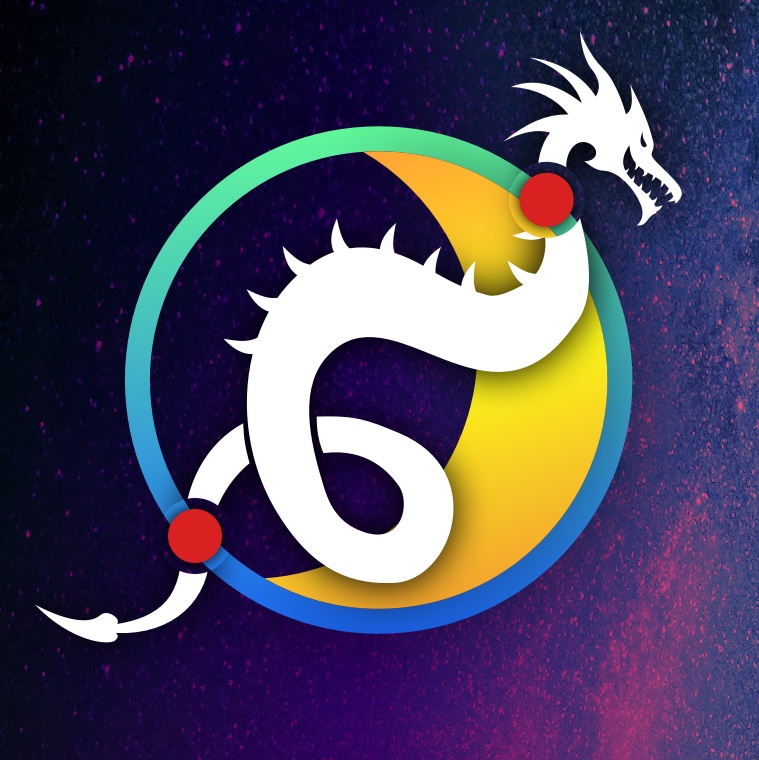
Traditionally the lunar nodes, aka Dragon’s Head and Tail, are perceived as the indicators of forces behind the unfoldment of personal fate and destiny. Their mysterious nature and relationship with eclipses was known since ancient times yet astrologers repeatedly changed their attitudes toward the nodes’ significance and interpretation.
Modern astrology is marked by acceptance of many kinds of theories and luckily treats the lunar nodes with all due respect. In many cases the nodes open a new dimension in natal chart readings providing significant clues to personal timeline and reasons behind prevalent patterns of emotions and actions.
The North Node and the South Node of the Moon are known to deal with the notion of individual’s past and future, they often act as significators of both challenges and opportunities that each human faces during their lifetime.
Before one can find an answer to the question “what does my future hold for me?”, one needs to look back in time — all things of the future have their roots in the past. That is why we should begin this story by looking at the past of the nodes themselves…
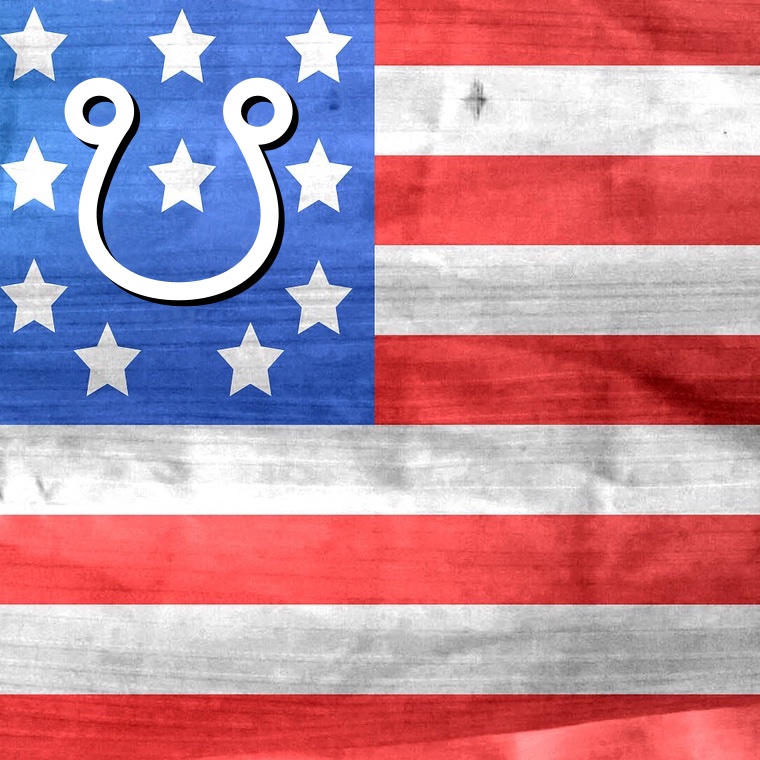
Extra case study: The 4th of July, 2019 — judgement of Saturn on the South Node
Saturn on the South Node is a potent symbol of a ticking clock reaching a milestone, learn more about what’s so special about this Independence Day.
The ancient times of Babylon and the discovery of the “saros” period
It is likely that the ancient Babylonians have discovered the existence of the lunar nodes by keeping track of solar and lunar eclipses, the observations perhaps spanning centuries of careful record keeping.
The kingdom of Babylon existed a long time ago — around 18th to 6th centuries BC, or mind boggling 2,600 to 20,000 years ago from now — and was known throughout the ancient world for its rich culture and science.
Babylonian astrologers recognised the repeating nature of solar eclipses — eclipses of similar strength and geometry tended to happen at regular intervals. Measured in lunar months such an interval turned out to be exactly 223 synodic months. This unit of time became known as “saros”.
TIP: Synodic month is a time interval between two identical Moon phases, for example from one New Moon to another.
What’s more, the Babylonians discovered that lunar eclipses of similar strength followed solar eclipses at exactly half saros mark. If saros is 18 lunar years 11 days 8 hours then half of that period is called “sar” and is equal to 9 lunar years and 5.5 days.
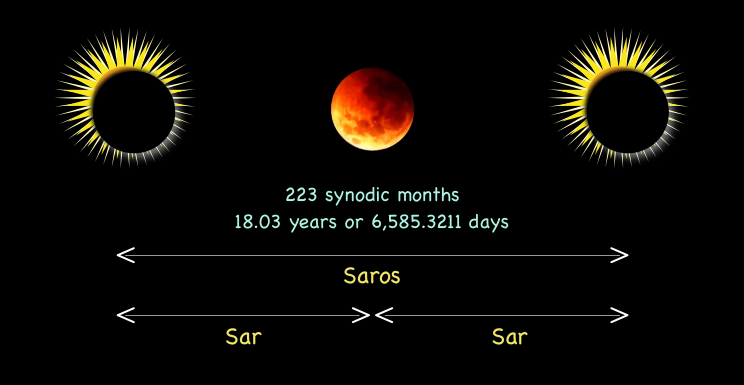
The word “saros” originates from the Greek σάρος that was itself borrowed from the Babylonian word “sāru” that meant both the number 3,600 and a measure of time. In Greek “saros” is said to mean “to repeat”.
What are the Moon’s nodes
The discovery of cyclical nature of eclipses — both solar and lunar — has led astronomers to a realisation that the Moon itself follows a certain periodic pattern of movement. And since every cycle has at least two defining points, an idea of special moments in time has emerged:
- a solar eclipse occurs when the Moon is in front of the Sun
- a lunar eclipse… is actually trickier…
… that blood-red Moon seemed to be obscured by something yet the ancients didn’t know that it was the Earth itself.
Hyper jumping to the current time equipped with precise astronomical knowledge, we now know what the nodes are. The nodes are the two points where the Moon orbit intersects with the plane of the Earth orbit around the Sun.
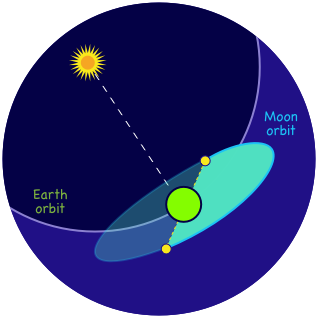
What’s more, every pair of orbiting cosmic bodies has such two nodal points. Orbital nodes is a universal principle describing two intersecting elliptical orbits. One node is called ascending (where the planet raises above the other’s orbital plane), another is called descending (where the planet dives beneath the other’s orbital plane).
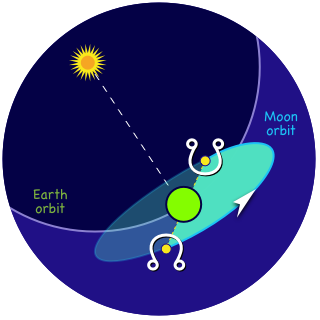
The lunar nodes is the Moon’s equivalent of solar equinoxes, see our earlier story “Equinoxes, Solstices and the idea of universal consciousness”
The table below expresses saros and nodal periods (two types) in solar years and days:
| Period | Solar years | Days |
|---|---|---|
| Saros | 18.03 years | 6,585.3211 days |
| Nodes draconic | 18.612958 years | 6,798.383 days |
| Nodes sidereal | 18.599525 years |
If during its New Moon or Full Moon phase, the Moon happens to be travelling in the vicinity of one of its orbital nodes it is also aligned with the Earth-Sun plane and thus either:
- obscures the Sun producing solar eclipse
- is obscured by the Earth producing lunar eclipse
Solar eclipses only happen during the New Moon and lunar eclipses only happen during the Full Moon. This may give some associations:
- New Moon’s solar eclipse is a “super emptiness of spirit”
- Full Moon’s lunar eclipse is an “obstruction of life’s flow”
Luckily enough not every passage of the Moon through the nodes results in an eclipse!
Every good story needs a dragon
Indian astronomy gave us a striking symbol for the up-down movement of the Moon’s orbit — the dragon.
Apparently, Hindu or Vedic astrology treats the nodes rather seriously and places them among the nine major planets. The ascending node is called Rahu and the descending node is called Ketu.
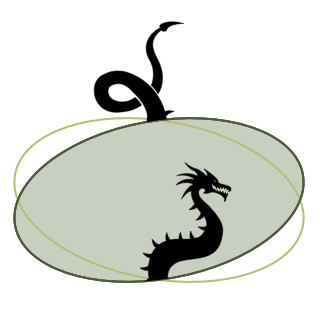
The Rahu-Ketu movement resembles a huge celestial serpent that moves in a wavy up and down manner and periodically swallows the Sun or the Moon. The ascending node is held responsible for swallowing the Sun while the descending node is held responsible for lunar eclipses. In its entirety the Rahuketu serpent is responsible for influencing the lives of the humans.
Arab, Greek and eventually Western astrology adopted the image of the serpent-dragon and the nodes became also known as the Dragon’s Head and the Dragon’s Tail.
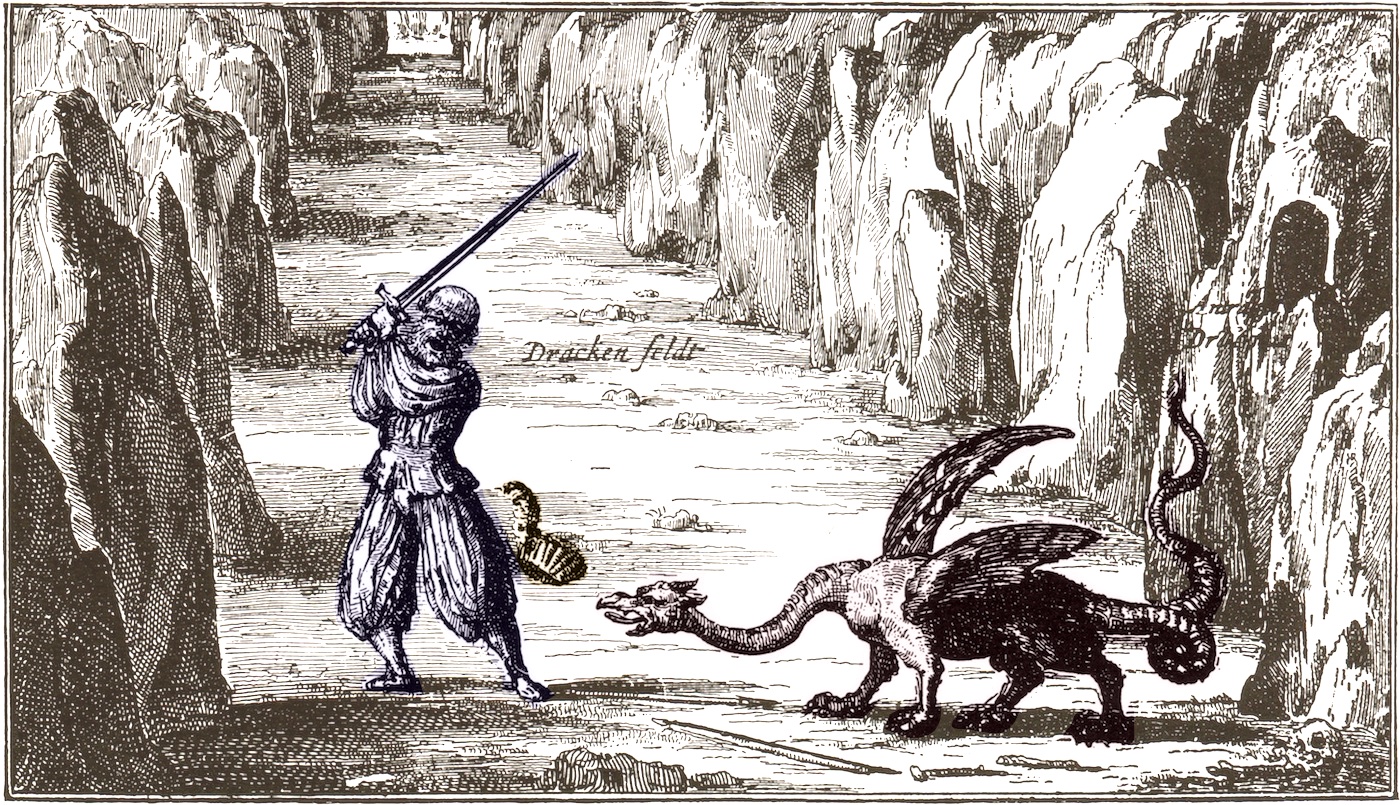
Unfortunately, the Western church found it more politically beneficial to equate the dragon with the forces of evil — libido and sexuality, the emanations of dragon’s vital energy, were considered “bad” by the puritanic mindset. Thus “slaying the dragon” became the only way to interact with the force.
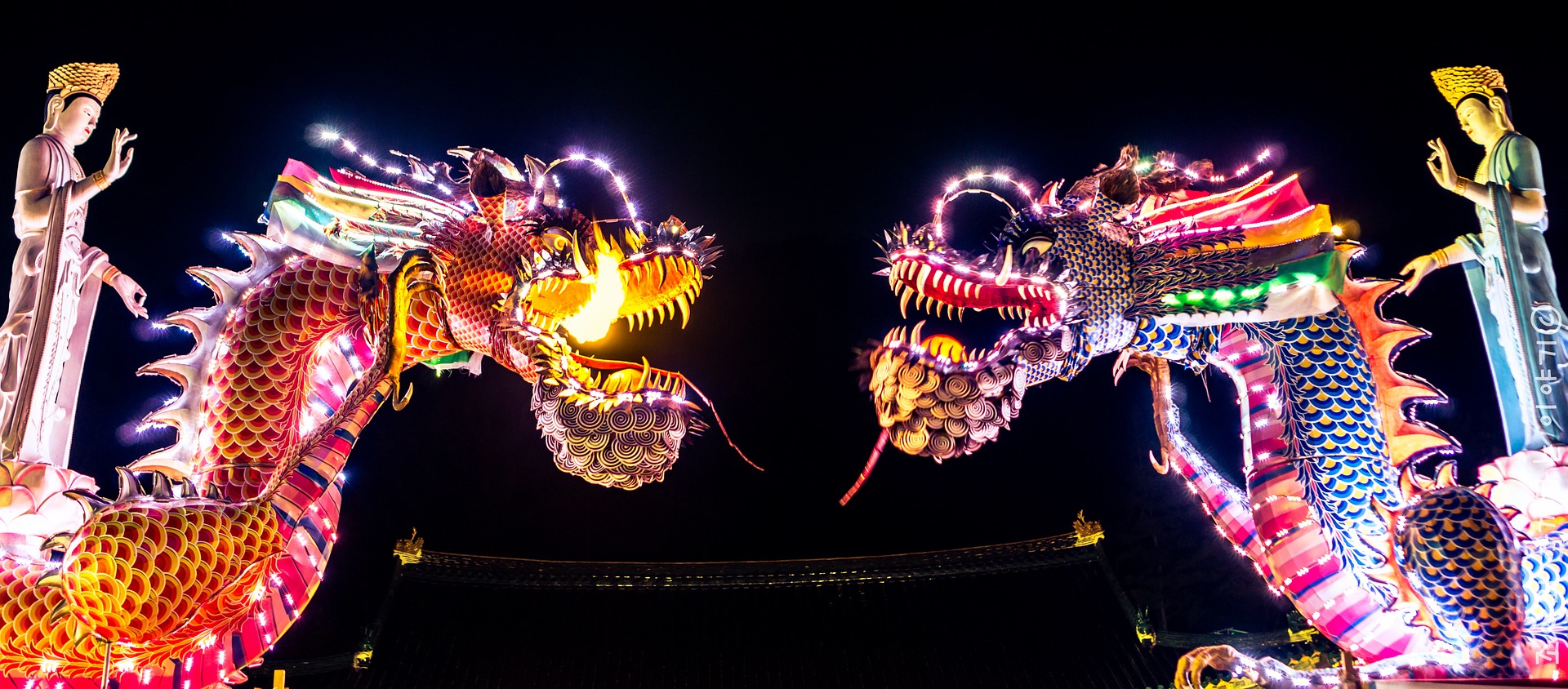
This dogmatic indoctrination resulted in endless superstitions and didn’t serve justice to the cosmic principle of dragon — the force of life and rejuvenation. Luckily enough, Chinese and other Asian cultures treat the dragon with all due respect and reverence.
Pre-modern Western astrology
Traditionally the nodes didn’t receive a proper treatment by earlier Western astrologers. A common attitude was to classify the descending South Node as malefic and the ascending North Node as beneficial.
The North Node was said to diminish negative effects of planet it’s conjunct with. Its 180º reflection, the South Node, was said to be of an exact opposite nature, it increased “malefic” effects of that planet.
Quite surprisingly, the nodes weren’t respected in the natal charts interpretations, unless the Moon was conjunct to one of them. Aspects to the nodes weren’t taken into account either, only conjunctions did matter.
The Head of the Dragon was considered to be masculine and of nature of Jupiter and sometimes Jupiter–Venus.
The Tail of the Dragon was considered to be… evil [sic] and of nature of Saturn or Saturn–Mars.
Using this overly simplified if not dismissive approach, one could still utilise the knowledge of the nodes in astrological interpretations and derive some additional insights from natal charts.

The opera has earned a reputation of being “cursed” as a number of incidents have happened during its performance possibly due to the intensity of pure bad luck that this piece of art presents so well.
Improving astrological meaning of the lunar nodes
The movement of the great celestial serpent represents unfoldment of life with its highs, lows and moments of equilibrium imbued with special meaning.
The nodes is another way to look at the highly changeable Moon, they rule over the overall progress of one’s life as opposed to lunar phases that influence monthly cycles of vital energies, emotions and moods.
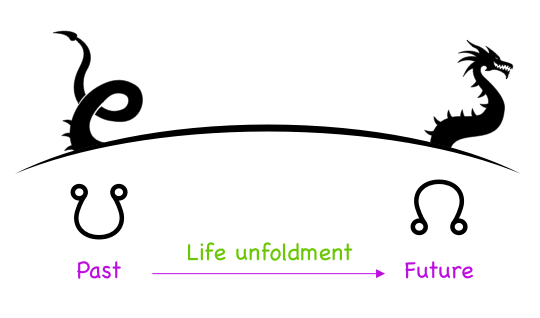
When Sanskrit texts were first translated in English, the translators made an insightful mistake: they assumed that Rahu (Dragon’s Head) was Uranus and Ketu (Dragon’s Tail) was Neptune.
This idea actually makes some sense from the standpoint of qualities of the nodes. A better way is to perceive the both nodes as a Uranus-Neptune duality in which the nodes borrow each other’s energies:
The north node is forward looking and advancing, brings originality, inspiration rooted in independence. Its downside can be potential confusion, illusion and neurotic addiction.
The south node is the roots, the doorway to one’s spiritual evolution and the force of compassion. Being related to past deeds and karma, the south node can express itself via eccentric behaviour and violence with potential amorality and impulsiveness.
Using this approach, the Dragon’s Head is more like Uranus–Neptune while the Dragon’s Tail is more like Neptune–Uranus. After all they are the two parts of one serpent!
A simpler approach
What most astrologers currently agree is that:
- the North Node represents destiny and future development
- the South Node stands for past actions and karma
From this standpoint, it does make sense to see the North Node as a Jupiterian force of expansion and benevolence, while the South Node is a Saturnian principle of limits and karma leading to inevitable contraction until the debts have been repaid.
Understanding the nodes and eclipses
What makes the nodes so special is their relationship to eclipses. Every time the Moon finds itself in the vicinity of the nodes there is a probability of an eclipse, either solar or lunar.
Eclipses can only happen during either solar-lunar conjunction (the New Moon) or solar-lunar opposition (the Full Moon) when the connection between the Sun, the Moon and the Earth is interrupted.
Thus eclipses always carry a potential for disturbance of the flow of life that is the Moon‘s domain of influence, or the creative flow expressed by the Sun’s energy. Not all eclipses are necessary “bad” and cause calamities. Most eclipses are quite harmless but some rare ones are powerful enough to introduce breaking points of a certain kind, depending on configuration of other significant planets.
Keeping this in mind helps to see the lunar nodes as powerful points that are mostly “asleep” but when awake bring about changes and breakages. Just like in the symbolism of resting dragon: a powerful sleeping force that unleashes volleys of fire when awaken.
The lunar nodes in natal charts
When interpreting natal charts, it is always beneficial to analyse the line of the nodes as a “past–future” vector relating to the notions of fate and destiny.
Planets or points that are conjunct with the south node often mean the past — past patterns or past incarnations during which the person may have been:
- doing something, either good or bad
- not doing, observing or indulging
Action or inaction, good or bad, truth or falsehood… all equally create karmic imprints that can work either for or against the person.
The South Node, or Dragon’s Tail, symbolises the past from which the individual has emerged. The person’s “tail” is likely to come with some kind of “historical luggage”.
Let’s look at examples when a certain planet is conjunct to the South Node…
Planet on the South Node
Any planet conjunct to the South Node signifies intense interaction of the individual with forces and principles of the planet that happened during past lives.
The interaction may have been blissful, productive or traumatic. But what is clear is that its nature was marked by intensity and left a lasting imprint in the person’s psyche.
For example, having Neptune on the South Node may mean that in the past the person have been:
- Excessively indulging in alcohol and other substance abuse
- Living idealistic life detached from reality
- Have been doing lots of spiritual work as a monk or a meditator
Another example could be Mars on the South Node:
- Warrior past lives that may have attracted traumatic or violent incidents
- Past lives in competitive environments, living on the edge
Either way, each planet can unfold its influence in either enabling or disabling manner. That’s the principle of karma in a nutshell.
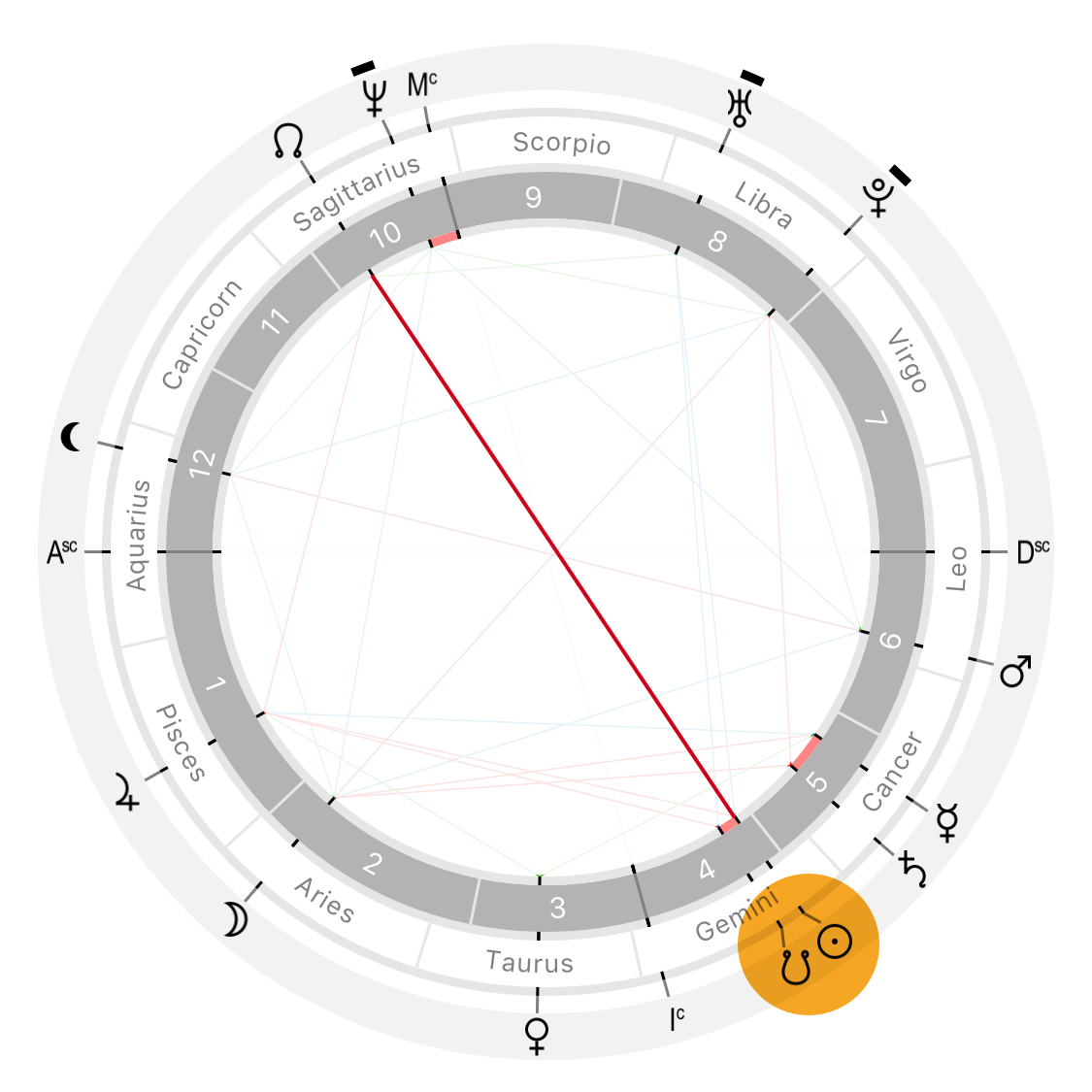
It is worth mentioning that the South Node also stands for occult powers and forces of the Underworld. The tail of the dragon has a Pluto connection — being in touch with Pluto energies ensures a better understanding of the dragon’s nature.
Other influences of the South Node
Another way to interpret the South Node is to look at “where the person is coming from”. The three factors that influence that:
- the South Node on an angle, usually ascendant or midheaven
- the South Node in a house
- the South Node in a Zodiac sign
In each of those cases carefully analyse what could the past mean. For example, the Dragon’s Tail on the ascendant or in the first house may signify an intense personality that have been formed during past lives:
- Stuck in old patterns, unable to let go and move forward without facing them first
- Power of “I am” that supports and propels into the future
As with pretty much everything in astrology, the meaning can vary and will depend on many other factors. A good approach is to choose a certain direction for further exploration, for example, exploring your relationship with power, the notion of me versus them, the degree of idealism versus practicality, etc.
The North Node and the future arrow
As much as the Dragon’s Tail is a deeply unconscious principle standing for what we have brought with us without fully realising or understanding, the Dragon’s Head is consciously looking into the future towards the opportunities it may bring.
The head as the seat of consciousness is responsible for making choices. The North Node arrow points at the areas in which our conscious focused cultivation may bring fruitful results that will eventually become the supporting Dragon’s Tail.
In a natal chart the North Node may be:
- conjunct to one or more planets
- conjunct to an angle like ascendant, midheaven, descendant or imum coeli
- positioned in a house
- positioned in a Zodiac sign
Aspects to the nodes
Since the nodes are always in a perfect 180º opposition, there are two strong configurations when a planet is:
- square to both nodes
- trine to one node and sextile to the opposite node
The case of square signifies that the planetary force is actively influencing the person’s timeline during this incarnation. It is important to be in touch with that planetary force and learn how to use the better side of its energy in one’s actions. Remember that “action” is the keyword for getting the most out of a square aspect.
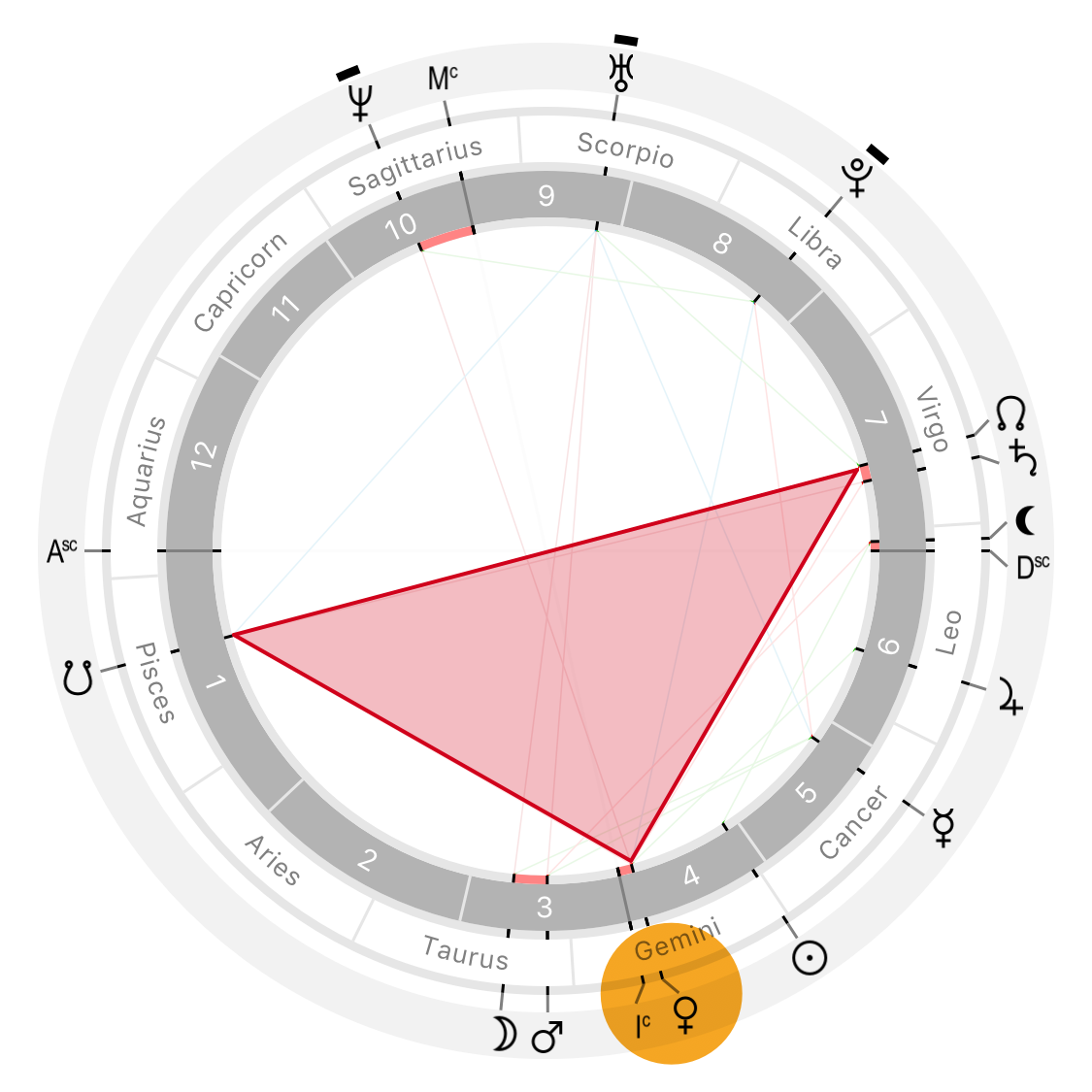
Imum Coeli square the nodes hints that the harmonising action of Venus is also required at the deepest level of the person’s psyche, the place of roots and family needs to be carefully explored and prepared to receive much needed love and care.
A trine–sextile configuration stands for benevolent help from the planet involved. Both aspects are harmonious and go well with the North Node symbolism and its nature of Jupiter. Using that planet’s energies in a creative and enthusiastic manner may take one further than expected.
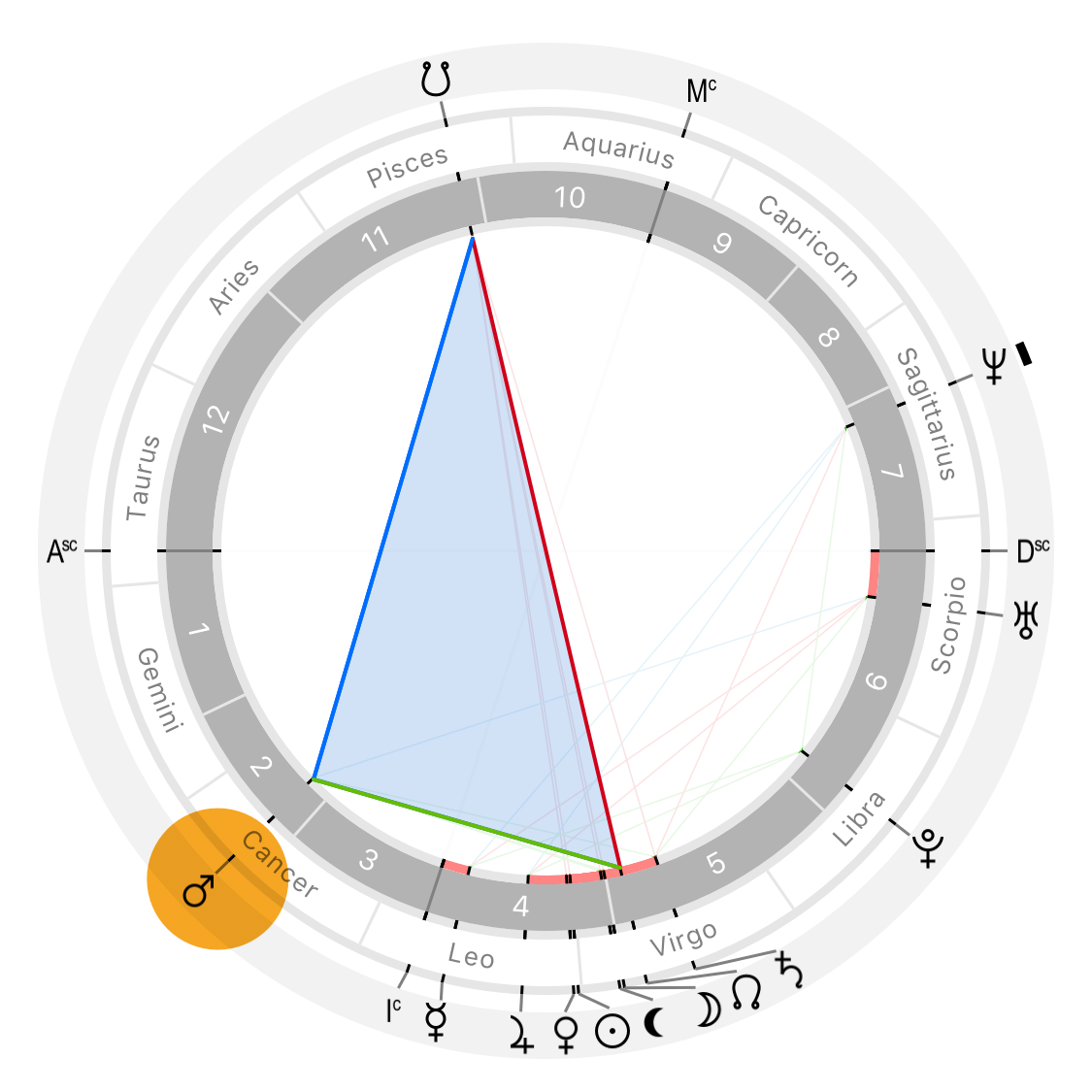
Unleashing the magic of the dragon
When well understood, the lunar nodes provide some extremely powerful hints that help us to navigate this complex environment called “my life on planet Earth”.
To briefly summarise the meaning of the nodes of the Moon in the context of fate and destiny:
- unconscious vs conscious
- choices already made vs actions to strive for
- past that either supports or obstructs the future
- the meaning of personal unfoldment and life
The image of the dragon, especially as it is perceived in Asian cultures, brings the sense of vitality, magic and force that rules over each individual incarnation on this planet.
It could be a wiser approach to embrace the dragon instead of trying to slay it. Understanding the past–future arrow as a sum total of both subconscious and conscious choices gives a plenty of room for hope, light and enthusiasm moving forward shaping one’s destiny while consciously owning one’s fate.
32 Comments
Simmons Louis
Very good article. It answered a lot of questions I had about the nodes.
Marcia
Thank you. Explained a lot.
Andre'a
Very helpful! Thank you… One question I have is in regards to the 2nd image below “What are the moon’s nodes”: it’s not clear here that the nodes are at the intersection between the ecliptic and the path of the moon. Am I understanding this correctly?
Time Nomad
Yes, you are right. The nodes are the intersection of the lunar orbital plane with the Sun-Earth orbital plane. This Wikipedia image provides a much better visual explanation: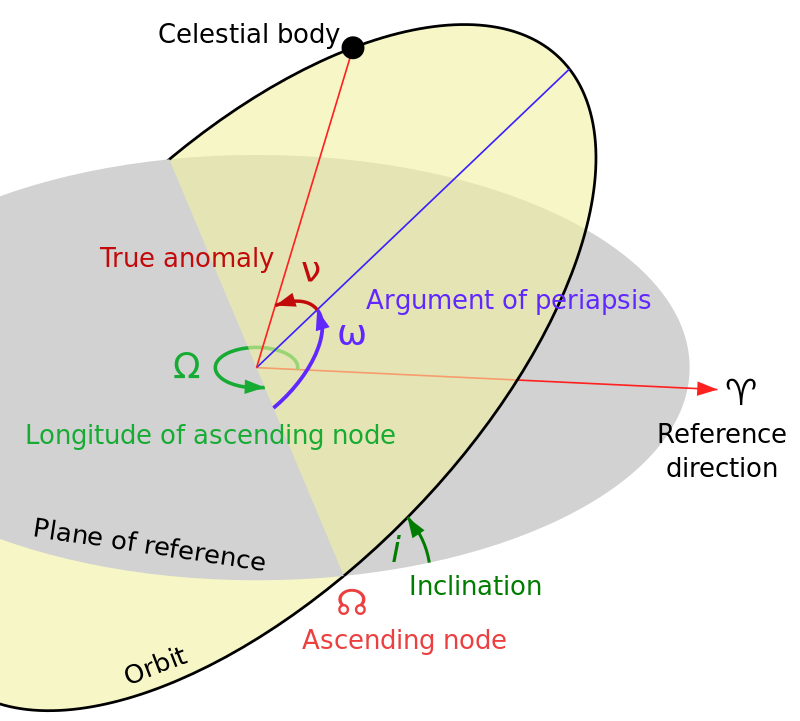
Andre'a
Thank you!
BLACKMOON
I dont think lunars nodes work in real life. My english is weak, but i’m trying to explain. Lunars node comes from vedic astrology, and the adaptation to western system was senseless. The fact is that in western system you have to be the opposite of what you are to get rid of karma, but this is impossible, maybe the hardest thing someone can do. On vedic the person is already rahu oriented,dont need to change any thing. For some years i tried to put the aries north node in practice(that is in conjunction with my aries rising), never worked, everytime i acted to be more independent and selfish, i suffered more and more bad consequences, the world dont tolerate this kind of atitude, people who run society want conformism and herd mentality. It was even bad to my mental health to follow this thing of lunars node. But in vedic system makes sense to me to have rahu in pisces in conjunct with the pisces rising(of vedic system). Sorry the poor english, but, i hope you understand. Lunars node are senseless, people should not think about it. I am a male, just like to use nickname of blackmoon.
Time Nomad
It’s safe to say that everything “works” in the sky but in different ways, often rather subtle and not so obvious. Each of us tends to experience astrological forces of planets and the nodes through the viewpoint of one’s own chart’s framework. This mean that certain things never work for one person while the other person’s experiences will be rather opposite. And that is completely normal and expected. What is needed is a transpersonal standpoint that allows to accept nuances and irregularities, an approach that avoids conflicts of views and broadens the perception of this world. This world and the creation are truly endless!
cj
thank you for your efforts.
Sofía Luna
How is it that in the Vedic System you have Piscis Rising and in the Western system it changes to an Aries Rising? I honestly don’t know much about different systems, so I would appreciate some insight.
Time Nomad
That’s due to the two Zodiacal systems that astrology uses, tropical and sidereal. Each system has its own merits and shortcomings yet both are valid, there are many ways to “slice the pie” of the celestial sphere!
You can learn more from this story The Sidereal Zodiac in astrology, its strengths and weaknesses
Joe
” i suffered more and more bad consequences, the world dont tolerate this kind of atitude, people who run society want conformism and herd mentality.”
In a sense in your response you have more validated the influence and effect of the nodes than disproved it.. Because going toward and manifesting your life direction indicated by house and sign position of the NN, involves just as much of a resistance, hardships and difficulties as you happen to be describing.
Yet life keeps bringing us back toward the direction and goals indicated by North Node until we master them through as many trial and errors as it takes. It’s both life direction and destiny and there is no way of avoiding it except leaving it as an extra karmic baggage in the next rebirth.
We all have our own NN challenges to deal with and our SN indicated skill, faculties and tendencies are the key toward learning how to handle and overcome the challenges of the NN.
Very best wishes to succeeding with yours.
Victoria Beer
Just found this brilliant site, so interesting and understandable thank you! After reading this post am wondering what the effect might be if your natal south node is in the same sign as your sun sign, or are you just doomed?!
Time Nomad
I wouldn’t worry too much. The “same sign” isn’t really a factor that projects any significant influence. Check if the Sun and the Node are in conjunction, only then there is a tangible accumulation of energies. And even then as everything in astrology, it can play itself out in a number of ways (some easy, some challenging) depending on multitude of other factors.
Joe
A very excellent article with an interesting historic perspective and very fitting interpretation of aspects to the Nodes. Great insight into the Venus square the Nodes as I happen to have it with a 1º orb. This aspect has such significance and impact in my chart that I’ve been studying it for a long time and still open to widening my understanding of its meaning, both as a standalone influence and as it blends with the energies of the overall chart.
Great site and look forward to coming back to read more of your articles. Keep up the great work!
Justin
The devil turned into a dragon. The nodes are an energy that does not know right from wrong, a energy (rahu ketu) that makes “a whole lot of nothing” (read the Mahabharata). It will use every trick in the book to try to deceive you and otheres into getting you all the stuff of the house its in. The north south energy cancles its self out because you cant have more of one without the other. I know it sounds wonderful but its just not. I have a saturn trine to my nn and im a capricorn.
Justin
You dont have to read the whole Mahabharata (god help you if you can sit through that shit) but it talks about r/k in the first 100 or so pages. The nn sn will enslave you under some initial pretense that its good but ultimately it just takes every bit of you.
AboutToUnleashTheDragon
Thank you for an informative and well written article.
I have the dragon guarding my IC and MC. My South Node in Virgo is a real dragon, itself guarded by Uranus, Jupiter and Pluto, Jupiter parked exactly on it at 26 Virgo and left Pluto to take a 4degree conjunction and Uranus a 3.
I feel that part of my lonely North Node remains hidden deep beneath the Piscean Sea. From the there it makes a 0°00’ trine to Neptune in Scorpio, it doesn’t get more nebulous than that, NN completes the Grand Water Trine with a 0°19’ trine to MC in Cancer, and closes the Kite with a 0°19’ sextile to the IC in Capricorn… a fact I was unconscious of.
My mystic rectangle includes the dragon, Neptune, Jupiter, Mercury, and Uranus. On top of that I have a Grand Water Trine that includes MC, dragon’s head and Neptune. In the past year I spent many hours reading on and trying to understand these configurations, and recently woke up to the fact that Saturn is about to transit my IC at 27 of Capricorn.
I had an extremely traumatic childhood but as I’m writing this, I have a big smile on my face because I’m about to Unleash the magic of the dragon, and the devil has reared his ugly head. Jealousy from incapable people who wont make it even if I were to deliver the Dragon Plan at their door step. This is not just business, this is my North Node, my destiny, my purpose on this planet. It is not theirs and that’s not going to change just because they are stuck, evil, thick headed and jealous. This is my path and i’m determined to turn it into reality. I took closer look at my chart and realised that I’ve got everything I need to make this a reality.
NN at 26 Pisces, SN conjunct Jupiter at 26 Virgo, MC 27 Cancer, IC 27 Capricorn. Capricorn is a cold and harsh place for the extra sensitive IC, this explains my harsh childhood. The only consolation is that Saturn’s influence at both the top and bottom of the sky at the time of my birth keeps me upright. The dwads revealed that Pluto, my chart ruler (Scorpio rising), is linked to Taurus my 7th. When not causing major damage, Pluto is a great anchor. Pluto and Saturn sitting on the angles, I’ve got what I need to unleash the dragon.
Collhic
You & I must be the same age. I also have NN at 26 Pisces. Jupiter, Pluto, Uranus also conjunct my SN 26 Virgo…AND conjuncts my MC at 25 Virgo. My 27 Pisces Moon also conjuncts the NN…and conjuncts the IC.
I relay all this because let me tell you…I had a doozy of a childhood as well. Coincidence?
Aquarius :)
Both my north and south nodes are square to the black moon(Lilith). How might that be Interpreted?
Time Nomad
I‘d take it as “the values of the Black Moon have a strong influence over my past-to-future trajectory.” Meaning the need to take the Black Moon seriously and learn to respect its influence. Look for what is Black Moon in you, learn to understand your own “shadow.”
And watch its transits over your natal Black Moon position (every 18 years) and also transits over the nodes (every 9 years). It’s time to strive fro clarity, as opposed to be swayed by emotions.
TaurusNN
Amazing article! I’ve been trying so hard to figure my path, but I confess that a lot of times I get more confused with what’s manifested in my life than clarity over what I should be doing! I have Jupiter in Aquarius on the 2nd house squaring SN in 11th Scorpio and NN 5th Taurus. Jupiter in the 2nd + Taurus NN in the 5th are like “JACKPOT”, right? Well….I can say the reality is exactly the opposite! Scarcity is winning - by a lot! But I guess that’s the challenge, right? Been trying to embody the abundant, loving and joyful mentality for years by now, but the reality in my face really hits strongly and honestly, at this point, I really really have no idea how to align with this NN path (sorry if my English was bad, I’m not American, lol)
Time Nomad
Jupiter is holding a square to your Nodes. But by itself Jupiter isn’t a very “manifesting” planet. Yes, it can bring luck but one needs more than Jupiter alone to succeed. Look at your NN position, it’s in the house of creativity. Look at the “productive” planets like Mars, Saturn, Venus, how can they help.
Bela
Hi! I think this is the only article on the internet which makes a deeper analysis of the nodes. Could you help me understand my situation? I have north node in Leo (7th house) and south node in aquarius (my rising sign - 1st house). No other planets in these houses.
Time Nomad
The nodes in signs & houses still give only generic information. Always see if there are any aspects involved (squares and trines in your case). The North Node in the Leo/7th may point at the process of affirmative self-development in the areas of relationships, both personal and work wise. Or possible challenges if those areas approached with an excessively pushy attitude. Ponder on those situations as they would give you a lot of information about yourself. Having the South Node in the 1st is an important position that usually points at “who was I in the past”, many of today’s tendencies stem right out of that. A topic for a focused self-exploration.
Nisha
Wonderful article on nodes. Very informative and well explained. I have too many aspects to my nodes so wonder which one will be considered most important. I have NN in Aries in 2nd house and SN in Libra in 8th conjunct Pluto(by 4 degrees) in Scorpio. My nodes have a tight square to Venus and not so tight square to Mars. So basically planets ruling both Aries and Libra are square my nodes!
Then I have NN trine Uranus and MC, NN trine Neptune,NN sextile Sun! Though the tightest orb is for NN square Venus.
So I wonder how do I really read my Nodes and it’s aspects situation?
Time Nomad
Square is certainly stronger than trine or sextile. Your SN-NN arrow is moving from Pluto/Scorpio (wow) towards Aries with Venus helping. I’d say the values of Venus provide a creative challenge to harmonise the movement from hidden and undeground towards outward fire and action. Look at the house where your NN is, that could give an extra clue as to what chapter of your personality is being targeted by this transition.
Irish
Thank you for this article! So much goodness in here not shared elsewhere I have read. I am still at a loss though, sadly. I am in the process of looking at my placidus vs whole sign natal chart to see which applies to me (I was born near the Canadian border). I tend to resonate more with whole sign at the moment, though. Lots more research and learning to do before I can really say…
Having said that, in placidus, my NN is in my Taurus 1st house (Aries ascendant @ 28). In this system/placement, I have a trine to Moon in my overly large 6th house Virgo, a square/semisquare to Mars (at 0) in my Libra portion of the 6th house (it’s about 1/2 Virgo and half Libra in placidus), and a trine to Pluto in my Virgo 6th. My SN in my 7th Scorpio house has a semi square to Mars in my Libra portion of my 6th house.
With whole sign, I have my NN in my Taurus second house with a trine to my 6th house Virgo Moon, a square/semisquare to Mars in my Libra 7th house (at 0), and a trine to Pluto in my Virgo 6th. My SN in my Scorpio 8th house with a semisquare to Mars in my Libra 7th house.
Those are pretty big changes when you consider 1st/7th vs 2nd/8th houses, and therein lies my struggle to define my path.
In both systems, I have Mars (ego, drive) blocked energy on my SN and NN but with a balance of trines and square/semisquare to soften that tension?
Does that blocked energy become mute in that case? Does that make me overly egotistical/narcissitic and lazy? Or does that make me introverted and high maintenance? lol… But then add in the different houses each system has my nodes in, I’m confused as to how that all would ‘look’.
Time Nomad
Looks like a few factors are at play. Your nodes perhaps point at the process of self-discovery during this life time. You are shaping who you are. The Moon usually brings all kinds of pulls and desires so you have to keep steady on your path. Learning to focus is the key.
KJ
Birth Chart Question:
— Jupiter (Aquarius) is the vertex of a T-square with north/south nodes. — Ketu (Scorpio) conjunct Moon (0.3°) — Rahu (Taurus) conjunct Mars (1.5°)
I’ve always wondered if there was significance to this.
Time Nomad
To put it simply the Moon on your past and Mars in on your future and all that is amplified by Jupiter. Looks like a personal configuration where the native is likely to oscillate between “what I feel” and “what I do”. There can be a pull towards emotionalising and over-reflecting that makes one feel uncomfortable about proactively moving forward. Past lives likely to be spent in contemplation. But the future actively challenges that. A recipe of being somewhat emotionally unsettled, work on grounding is requited. Need for active checking in with reality and making concrete steps. It’s a kind of conflict between two rather incompatible principles (Moon and Mars just don’t mix). The golden path forward requires achieving clarity in every situation, that can align both planets on one common goal.
SD
Thank you for this interesting article and others on your site. The images are great to download also. I have NN in Anaretic Gemini degree on the cusp of the 12th house. It is also exactly conjunct Venus on 12th cusp, And conjunct Mars in Cancer 12th house. Further, I have 8th house SaturnR in a trine to the above…. My life has been Cursed on an emotional level, having suffered the deepest, darkest loneliness Ever. Am I forever denied the love I want?
Time Nomad
Venus on the North Node points at the search for harmony as the way forward. But Mars adds unneeded venom and that may confuse your system. Most likely your Moon is unnecessary bashed by an excess of emotions (Venus-Mars are good at that). First goal is inner peace, identifying and letting go of self-loathing. When the Moon is suppressed, nothing helps more than extended periods of time in nature. That will balance emotions and allow for letting go. Nature can truly show you that you’re not alone, loneliness is a very convincing illusion.